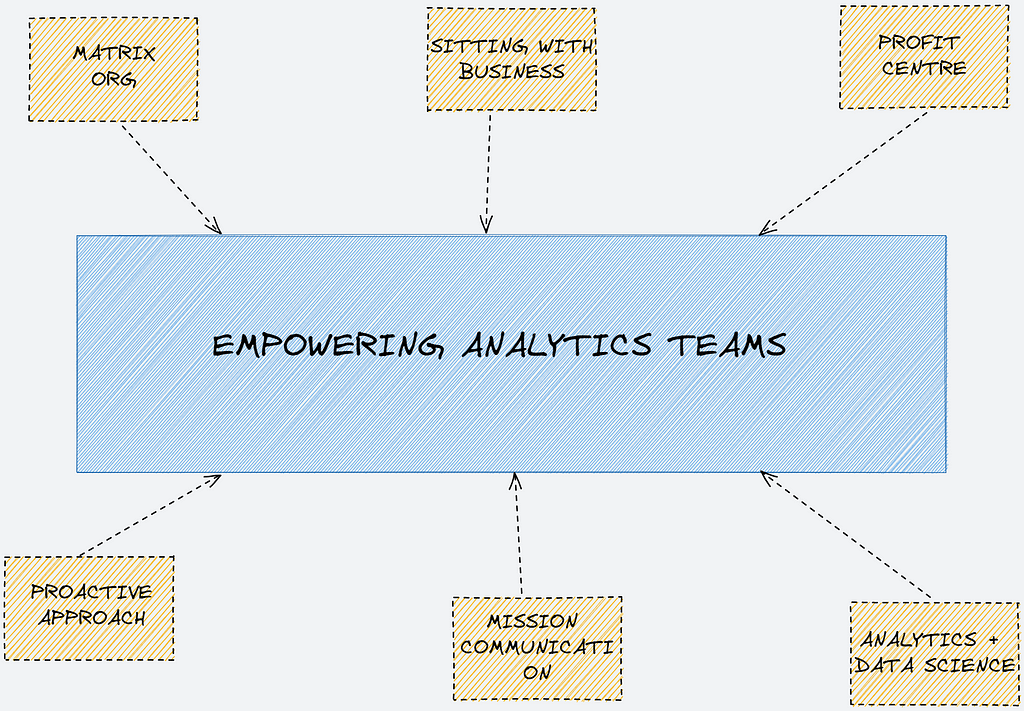https://ift.tt/W9ACbOQ How can businesses reduce analysts attrition? In this post I have identified six straightforward must-haves to make ...
How can businesses reduce analysts attrition? In this post I have identified six straightforward must-haves to make analytics teams successful.

Stories of frustrated analysts[1] are becoming more and more common. Many businesses don’t have a full understanding of the capabilities and range of scope of a modern analytics team, usually senior management believes it is a mix between a BI team and an old-style “IT” department, often the team is completely detached from the product and the strategy.
The following are the most recurrent sources of disappointment:
1) Analytics as a cart to fill with items from a shopping list — This happens when the business side considers the analytics teams as mere executors of a list of requirements that they provide on a certain cadence
2) Analytics seen as the entry level of data science focused on machine learning and algorithms.
In order to improve the added value generated by analytics and to boost the morale and the retention of the analysts, businesses must embrace the following points in their data strategies.

1) Having a Matrix organization
The best organizational structure for a high performing analytics team is undoubtedly the matrix.
The matrix framework enables members to benefit from knowledge coming from cross-pollination for being part of an overall functional analytics team while at the same time acquiring a proper T-shaped expertise of the business field where they have been allocated.
Another advantage of the matrix is that it guarantees analysts to be independent and unbiased from the business/operational teams. They belong to an outer department, which means they are not influenced by having a direct reporting line with business stakeholders.
2) Allowing analysts to sit at the same table where business decisions are taken
Analytics needs to be considered the right arm of product managers. Analysts need to be actively involved in the planning process of strategy and in the creation of the business case. They are well equipped to craft and shape the business strategy, through their data-driven business acumen.
Embroiling the analytics teams after the business decisions are taken is the perfect way to alienate the analysts and to underuse their potential.
3) Considering analytics teams as a profit centre rather than cost centre
Historically, BI and analytics teams have typically been considered as cost centres. It means that the metrics of success for those are measured through inputs and resources optimization and there is a disincentive to consider them as strategic resources for the business. Moreover, cost centres are the first to have budget reductions and cuts during downturns.
On the contrary, revenue/profit centres are measured through the contribution to the overall revenues and are considered critical for the business success. There are different ways to consider the impact of analytics on the top line:
· Monetization of the internal data as data products
· The role of analytics in the enablement side to pursue business objectives
· Optimization and strategy pivots achieved through the analytics teams.
4) Foster a culture of proactiveness
Analytics teams are often regarded as modern Greek oracles. This happens when their ultimate goal is to be consulted, to cook a semi-obscure answer and then wait up for the next request.
In reality, the highest added value is when analytics teams shift from passiveness and reactiveness to being proactive.
Surely, analytics teams need to answer critical questions and to shed light on topics as requested. At the same time, as analysts are much closer to a wide range of data points, they are well capable to drive business projects without having the kicking input from the business side. Analytics led projects are powerful and impactful as they are born through a scientific data driven approach and connecting the dots of a myriad of hidden data signals that are otherwise difficult to spot from other teams.
5) Analytics mission evangelization
Analytics team mission and way of working need to be properly documented and these need to be spread across the entire organization. A shared understanding on how analytics teams work across the organization is paramount for its stability and efficacy in the medium-long term. One of the most shared pain in the analytics are the discrepancies on how its stakeholders think, understand and liaise with analysts. A fractured framework creates different ways of living the role, raising frustration among analysts as it will create sub-teams depending on the stakeholders they are dealing with and persona dependencies.
6) Analytics and data science working together
Analysts and data scientists don’t compete; in fact they complete each other. In many organizations roles sit independently with projects seldom overlapping. Being part of the same family under the same roof plays a major reason to push such profiles to combine both their efforts and work. They both live and breathe data, their combined knowledge covers a big chunk of the overall data value chain and their skills have a clear affinity.
Finally, analytics should never be considered as the entry level of data science (machine learning). The two disciplines are complimentary and require different skills and both can elevate the value of the data. Careers and growth paths in analytics must be regarded as high as pure machine learning and algorithm.
[1] the actual nomenclature is “Full Stack Analysts”, as they are required to have full ownership of the data value chain, in this other post, https://medium.com/p/a78e8bd60f32, I deepen into the role details
How to Empower Analytics Teams was originally published in Towards Data Science on Medium, where people are continuing the conversation by highlighting and responding to this story.
from Towards Data Science - Medium https://ift.tt/Wn9N5VU
via RiYo Analytics

No comments